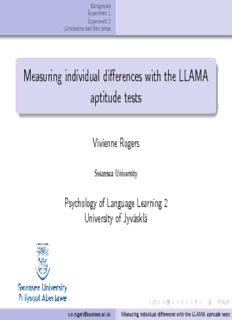
Measuring individual differences with the LLAMA aptitude tests PDF
Preview Measuring individual differences with the LLAMA aptitude tests
Background Experiment1 Experiment2 ConclusionsandNextsteps Measuring individual di↵erences with the LLAMA aptitude tests Vivienne Rogers SwanseaUniversity Psychology of Language Learning 2 University of Jyv¨askl¨a [email protected] Measuringindividualdi↵erenceswiththeLLAMAaptitudetests Background Experiment1 Experiment2 ConclusionsandNextsteps Outline 1 Background 2 Experiment 1 Methodology Results & Discussion 3 Experiment 2 Methodology Results & Discussion 4 Conclusions and Next steps [email protected] Measuringindividualdi↵erenceswiththeLLAMAaptitudetests Background Experiment1 Experiment2 ConclusionsandNextsteps What is aptitude? the amount of time a student needs to learn a given task, unit of instruction, or curriculum to an acceptable criterion of mastery under optimal conditions of instruction and student motivation. (Carroll 1990: 26) phonemic coding ability, grammatical sensitivity, inductive language learning ability rote-learning ability [email protected] Measuringindividualdi↵erenceswiththeLLAMAaptitudetests Background Experiment1 Experiment2 ConclusionsandNextsteps Overview of Aptitude Li (2015) Construct validity: meta analysis of 66 studies. Concluded: Aptitude is independent of other individual di↵erences, e.g. motivation. executive working memory (EWM) more strongly associated with aptitude than phonological short-term memory (PSTM). strong predictor of general proficiency but not vocabulary learning or L2 writing. di↵erent components predicted di↵erent aspects of learning. [email protected] Measuringindividualdi↵erenceswiththeLLAMAaptitudetests Background Experiment1 Experiment2 ConclusionsandNextsteps Background Aptitude and Working Memory Linck et al (2013): relevance of PSTM to advanced learners. Gran˜ena (2015): two types of aptitude (explicit and implicit) linked to di↵erent cognitive styles (rational versus intuitive). Motivation and anxiety (Li 2015) motivation and aptitude separate negative correlation between anxiety and aptitude. Sparks & Patton (2013): anxiety as result not cause of low aptitude [email protected] Measuringindividualdi↵erenceswiththeLLAMAaptitudetests Background Experiment1 Experiment2 ConclusionsandNextsteps Aptitude tests MLAT: Modern Languages Aptitude Test Carroll & Sapon (1959) Four components: learning words out of context grammatical sensitivity phonetic sensitivity inductive learning ability PLAB: Pimsleur Modern Languages Aptitude Battery Pimsleur (1966) English vocabulary size as measure of overall verbal ability language analysis measures sound discrimination measures motivation [email protected] Measuringindividualdi↵erenceswiththeLLAMAaptitudetests Background Experiment1 Experiment2 ConclusionsandNextsteps LLAMA tests: background Developed by Paul Meara (2005) free, loosely based on MLAT increasingly used in research projects (over 1000 papers reference the LLAMA tests). Has not been fully validated. [email protected] Measuringindividualdi↵erenceswiththeLLAMAaptitudetests Background Experiment1 Experiment2 ConclusionsandNextsteps LLAMA tests Not only designed for English - language neutral Four components LLAMA B = vocabulary measure LLAMA D = sound recognition (implicit learning) LLAMA E = sound-symbol correspondence LLAMA F = grammatical inferencing [email protected] Measuringindividualdi↵erenceswiththeLLAMAaptitudetests Background Experiment1 Experiment2 ConclusionsandNextsteps LLAMA tests [email protected] Measuringindividualdi↵erenceswiththeLLAMAaptitudetests Background Experiment1 Experiment2 ConclusionsandNextsteps Previous validation work: Gran˜ena (2013) Gran˜ena (2013): Internal consistency, Gender and Language neutrality n=187 aged 18-39 L1s: Spanish, Chinese and English internal consistency but two forms of aptitude LLAMA D measuring something di↵erent to the others LLAMA D measures implicit and others explicit? [email protected] Measuringindividualdi↵erenceswiththeLLAMAaptitudetests
Description: